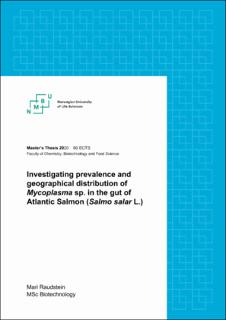| dc.contributor.advisor | Rudi, Knut | |
| dc.contributor.advisor | Snipen, Lars-Gustav | |
| dc.contributor.author | Raudstein, Mari | |
| dc.date.accessioned | 2020-09-30T08:48:13Z | |
| dc.date.available | 2020-09-30T08:48:13Z | |
| dc.date.issued | 2020 | |
| dc.identifier.uri | https://hdl.handle.net/11250/2680437 | |
| dc.description.abstract | The fish gut microbiota has gotten considerable attention in recent years, and the microbes harboring the intestine of fish are thought to grant the host various effects related to size, metabolism, feeding behavior, and immune response. A Mycoplasma species has been discovered as highly abundant in the salmon gut. However, the resident strain has not yet been isolated. Knowledge regarding its colonization and the impact it may have on the host is, therefore, limited. This study aimed to map the prevalence and geographical distribution of Mycoplasma in the salmon gut and discover its potential role as part of the gut microbiota.
Salmon gut content was sampled for both cultivation purposes and direct DNA analyses in this project. Samples were collected from two salmon farms in Norway, Skjervøy (n = 23) and Bømlo (n = 19), and one in Chile (n = 20). A selection of Bømlo samples (n = 10) was cultivated in enriched growth medium. The prevalence of Mycoplasma at different geographical sites was investigated by analyzing the bacterial composition in the Bømlo and Chile samples using 16S rRNA gene sequencing. Moreover, selected samples from Bømlo (n = 4), Skjervøy (n = 7), and Chile (n = 1) were further processed for whole-genome shotgun sequencing to obtain genomic information of the salmon-associated Mycoplasma.
Mycoplasma was found abundantly in Norwegian salmon but was not detected in Chilean salmon. Thus, in this study, we observed a geographical difference (p = 0.00023) in the mycoplasmas’ prevalence in the gut of farmed Atlantic salmon. The underlying reasons for the absence of Mycoplasma in Chilean salmon must be further investigated to explain our findings. Further, we found that the salmon-associated Mycoplasma’s DNA was most frequently classified as M. penetrans, which may suggest relatedness between these species. Whether the salmon Mycoplasma exhibits pathogenic or protective characteristics is not known. However, given the seemingly large prevalence of mycoplasmas in salmon, it is likely they exist in the gut microbiota as commensals. Further research is necessary to discover potential negative or positive impacts the salmon-associated Mycoplasma might have on the physiology and immunology of the fish. | en_US |
| dc.description.abstract | Tarmmikrobiotaen til fisk har fått auka merksemd dei siste åra, og mikroorganismane som utgjer denne har truleg innverknad på verten relatert til storleik, metabolisme, fôringsåtferd og immunrespons. Ein Mykoplasma-art har blitt oppdaga i rikelege mengder i laksetarmen. Arten er enno ikkje isolert, og det er lite kunnskap om denne bakterien si kolonisering, og om verknaden den kan ha på verten. Målet med denne studien var difor å kartlegge utbreiinga, samt den geografiske fordelinga av Mykoplasma i laksetarm, og å undersøke kva rolle denne bakterien potensielt har som del av tarmmikrobiotaen. | en_US |
| dc.language.iso | eng | en_US |
| dc.publisher | Norwegian University of Life Sciences, Ås | en_US |
| dc.rights | Attribution-NonCommercial-NoDerivatives 4.0 Internasjonal | * |
| dc.rights.uri | http://creativecommons.org/licenses/by-nc-nd/4.0/deed.no | * |
| dc.subject | Gut microbiota | en_US |
| dc.title | Investigating prevalence and geographical distribution of Mycoplasma sp. in the gut of Atlantic salmon (Salmo salar L.) | en_US |
| dc.type | Master thesis | en_US |
| dc.description.version | submittedVersion | en_US |
| dc.source.pagenumber | 81 | en_US |
| dc.description.localcode | M-BIOTEK | en_US |

